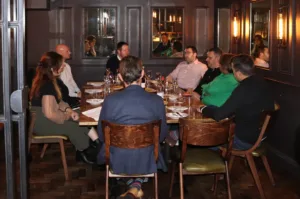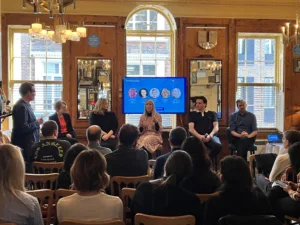At NDA’s Ecommerce Roundtable, we were joined by Mark Choueke, Marketing Director at Mention Me; Beth Oddy, UK Sales Manager at Tribe; Kristina Kaganer, VP of Product Development at Publicis Commerce; Liz Wright, Global Head of Ecommerce & Partnerships at Neal’s Yard Remedies; Richard Kelly, Founder & CEO at Adimo; and Matt Bailey, Director of Sales at Productsup to discuss the state of ecommerce.
Ecommerce has exploded in growth over the course of the pandemic after several years of steady growth within the space, as people were forced to spend more time buying goods online with the majority of physical stores shut for much of the past year or so.
Brands and retailers have had to adapt in ways they couldn’t have foreseen and accelerate their digital strategies. Now, on the back of shops reopening, brands and retailers are once again having to shift their strategies to incorporate the return to the high street.
Mention Me’s Choueke sees this as being the “third era of ecommerce”, with the first being when websites were solely used as online shop windows and the second being when everything was focused on optimisation, personalisation, and automation.
“I feel like we’re entering an era where personalisation is seen as a more organic human endeavour,” he said. “I think AI and automation is still right there, but people are accepting that there’s still a way to go and there’s a new adventure to see if we can make it real in the era of people not populating high streets as much.”
Let’s get physical
A big factor in the future of retail is going to be the part that the high street plays alongside an ecommerce space that has become first-nature to many over the pandemic. Will the physical store still have relevance in the world we now live in?
“My gut feeling is that the retail store is still going to be hugely important. For us, it’s more about creating an experience in store,” said Neal’s Yard Remedies’ Wright. “Omnichannel has been a topic of discussion for years, but I think now more than ever, it’s genuinely about being where the customer wants to be – whether that’s on our website, whether it’s Amazon, or whether it’s in the physical store. Convenience and adapting to a customer’s personal needs in an empathetic and personalised way is key.
“We know that we have a different customer who shops in our stores versus who shops on Amazon, for example. However, we also have many customers who shop across multiple platforms and touchpoints, particularly following the events over the last 12 months.
“It’s really about holistic planning across all platforms. So, thinking about what we’re doing on Amazon, what we’re doing on .com, what we’re doing on retailer websites, and what we’re doing in-store.”
Adimo’s Kelly sees the current retail environment as a chance, particularly within the FMCG space, to deliver a more convenient physical experience for customers by combining the online world and the offline world.
“Given the amount of data that exists in an online grocery account, there’s lots of potential to develop convenience,” he explained. “So, I can tell Tesco when I’m going to be popping in and, based on that, they’ll know that they could schedule an appointment with the cheese people and give me some nice free samples. The tactile, great benefits about going to the supermarket that we’ve probably lost.”
For Productsup’s Bailey, the growth of click and collect is the trend he has great interest in. Because of this, he feels that we will continue to see the likes of B&Q and Decathlon closing down their warehouse-style stores and opt for smaller, local branches to provide click and collect services to customers.
“The trend of them building these huge warehouses on out-of-town industrial estates is moving, they’re now building stores to take products to where people are,” said Bailey. “People are more attuned to ordering online and popping in to collect it. So, as well as the experiential thing, there’s a convenience factor as well. You want to be able to buy what you want, where you are – and brands are embracing that.”
Feeling social
One of the other big developments we’ve seen over the past year or so is the growth of social commerce. Tribe’s Oddy believes that, while the brick-and-mortar store still has its place, social media is now at the forefront of purchase decisions.
“87% of people go to social media to get recommendations before they purchase and see what micro influencers that they relate to are using,” she said. “So, it’s about being in that place at that time for those reactive purchases, where you might just be influenced at that moment. And then you’re able to purchase straight from the app you’re in. When you’re going into a store, it might be something planned, maybe for a more expensive thing that you want to go in and test.
“Social is creating a completely different shopping experience and making this whole ecommerce world less about the chore of buying, and trying to replicate the fun and the experience of going to the high street, but online.”
For Publicis Commerce’s Kaganer, social is the ideal place to drive commerce because it’s one of the few media channels that offers genuine insight into products. The micro influencers and other ‘standard’ users are all people that actually use the products they are talking about.
“The beauty of social media is that it’s people that are next door to you. It’s quite different when you look at a lot of the mass media channels. Even taking the same content and putting it on something that has massive reach, you lose some of that appeal because it feels less authentic, it feels less genuine,” explained Kaganer.
“I think the brands that are doing it best are the ones that are creating different social experiences on each channel. Social commerce is less about buying the product, it’s also about the ‘I want you to like the fact that I’m buying the product and I want you to engage with me’. “









